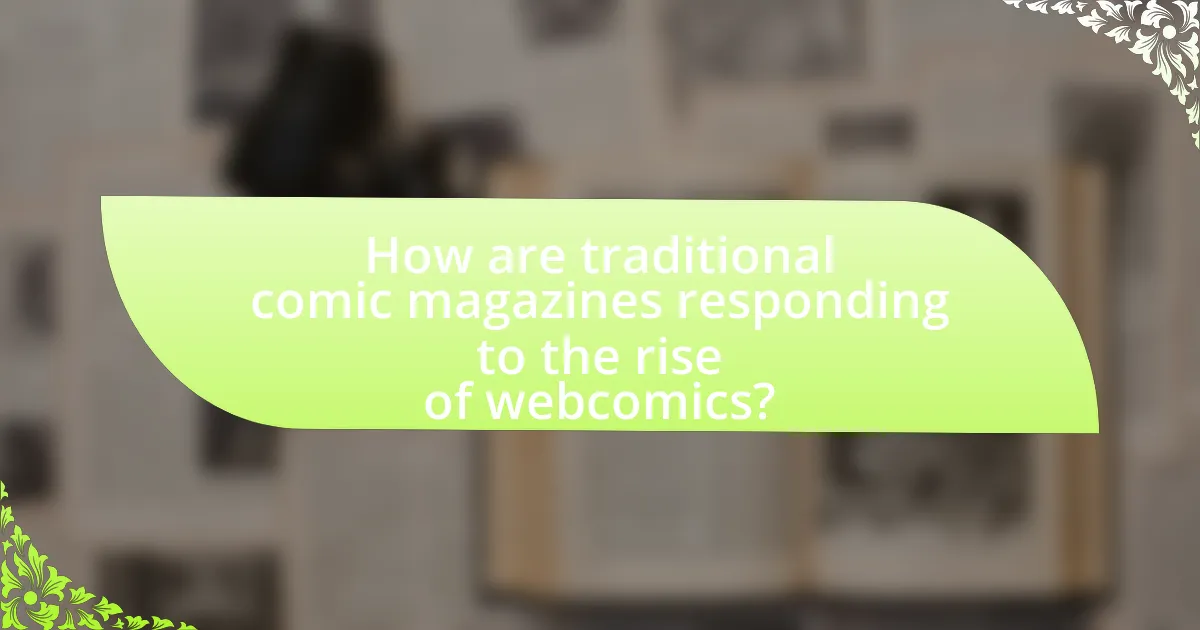Webcomics have emerged as a transformative force in the comic industry, significantly impacting traditional comic magazines through changes in distribution, audience engagement, and content diversity. This article examines how webcomics have shifted the focus from print to digital platforms, allowing creators to reach global audiences and prompting traditional publishers to adapt their formats and offerings. Key topics include the defining characteristics of webcomics, their appeal to diverse demographics, the role of social media in promotion, and the strategies traditional magazines are employing to compete with this new medium. Additionally, the article explores the collaborative efforts between webcomic creators and established publishers, highlighting the evolving landscape of comic creation and readership.

What is the Influence of Webcomics on Traditional Comic Magazines?
Webcomics have significantly influenced traditional comic magazines by altering distribution methods, audience engagement, and content diversity. The rise of webcomics has shifted the focus from print to digital platforms, allowing creators to reach global audiences without the constraints of traditional publishing. This shift has led traditional comic magazines to adapt by incorporating online content and exploring digital formats to retain readership. Furthermore, webcomics often feature diverse narratives and experimental art styles, prompting traditional magazines to broaden their content offerings to appeal to a wider demographic. The impact is evident in the increasing collaboration between webcomic creators and established comic publishers, reflecting a blending of the two mediums.
How have webcomics emerged as a significant medium in the comic industry?
Webcomics have emerged as a significant medium in the comic industry by providing creators with direct access to audiences without the constraints of traditional publishing. This shift has been facilitated by the rise of digital platforms, which allow for immediate distribution and interaction with readers. According to a 2021 report by the Comic Book Legal Defense Fund, webcomics have seen a 200% increase in readership over the past decade, highlighting their growing popularity. Additionally, platforms like Webtoon and Tapas have enabled creators to monetize their work through ad revenue and subscriptions, further solidifying webcomics’ role in the industry. This democratization of content creation has led to diverse storytelling and artistic styles, attracting a wider audience and influencing traditional comic magazines to adapt their formats and distribution methods.
What are the defining characteristics of webcomics compared to traditional comics?
Webcomics are primarily characterized by their digital format, accessibility, and often serialized storytelling, which distinguishes them from traditional comics. Unlike traditional comics that are typically published in print and may follow a fixed release schedule, webcomics can be updated frequently and are accessible to a global audience via the internet. Additionally, webcomics often allow for greater experimentation in art styles and narrative structures, as creators are not bound by the constraints of print publishing. This flexibility is supported by platforms that enable direct interaction with readers, fostering community engagement and feedback.
How has the accessibility of webcomics changed the landscape of comic creation?
The accessibility of webcomics has democratized comic creation, allowing a diverse range of creators to publish their work without traditional barriers. This shift has led to an explosion of unique voices and styles, as platforms like Webtoon and Tapas enable artists to reach global audiences directly. According to a 2021 report by the Comic Book Legal Defense Fund, over 60% of webcomic creators reported that they felt empowered to share their stories due to the low cost and ease of online publishing. Consequently, traditional comic publishers are increasingly adapting to this trend by seeking out webcomic talent and incorporating webcomic aesthetics into their offerings, reflecting the significant impact of webcomics on the overall comic landscape.
What impact do webcomics have on the readership of traditional comic magazines?
Webcomics significantly reduce the readership of traditional comic magazines by providing accessible, diverse, and often free content online. The rise of platforms like Webtoon and Tapas has attracted a younger audience that prefers digital formats over print, leading to a decline in sales for traditional comic magazines. For instance, a 2020 report indicated that print comic sales in the U.S. dropped by 20% over five years, coinciding with the increasing popularity of webcomics. This shift highlights how webcomics cater to evolving consumer preferences, ultimately impacting the traditional comic magazine market.
How do webcomics attract different demographics compared to traditional comics?
Webcomics attract different demographics compared to traditional comics primarily through accessibility and diverse content. Unlike traditional comics, which often require physical purchase or subscription, webcomics are freely available online, allowing a wider audience to engage without financial barriers. This accessibility has led to a significant increase in readership among younger audiences, particularly those aged 18-34, who prefer digital formats.
Additionally, webcomics often feature a broader range of genres and themes, catering to niche interests and underrepresented voices. For instance, studies show that webcomics frequently explore topics such as LGBTQ+ experiences and multicultural narratives, which are less commonly found in mainstream traditional comics. This inclusivity attracts diverse demographic groups, including women and marginalized communities, who may feel alienated by the conventional comic book industry.
The combination of free access and varied content effectively draws in a wider and more diverse audience, demonstrating how webcomics have reshaped the landscape of comic readership.
What role does social media play in promoting webcomics over traditional magazines?
Social media plays a crucial role in promoting webcomics by providing a direct and accessible platform for creators to reach audiences, unlike traditional magazines which rely on print distribution. Platforms like Instagram, Twitter, and Webtoon allow webcomic artists to share their work instantly, engage with fans, and build communities around their content. According to a 2021 survey by the Comic Book Legal Defense Fund, 70% of webcomic creators reported that social media was their primary method for audience engagement and promotion, highlighting its effectiveness compared to the slower, more limited reach of traditional magazine advertising.
Why are traditional comic magazines adapting to the influence of webcomics?
Traditional comic magazines are adapting to the influence of webcomics to remain relevant in a rapidly changing digital landscape. The rise of webcomics has shifted audience preferences towards more accessible, diverse, and innovative storytelling formats, prompting traditional publishers to incorporate similar elements. For instance, webcomics often feature shorter, episodic content that caters to mobile consumption, which traditional magazines are now emulating to attract younger readers who favor digital platforms. Additionally, webcomics have demonstrated the viability of direct creator-to-audience engagement, leading traditional magazines to explore new distribution methods and interactive content to enhance reader involvement. This adaptation is essential for traditional comic magazines to compete effectively and sustain their readership in an era dominated by digital media.
What strategies are traditional comic magazines employing to compete with webcomics?
Traditional comic magazines are employing strategies such as diversifying content, enhancing digital presence, and engaging with audiences through social media to compete with webcomics. By diversifying content, these magazines are incorporating various genres and themes that appeal to a broader audience, thus attracting readers who might otherwise turn to webcomics. Enhancing digital presence involves creating online platforms where readers can access digital versions of comics, often with interactive features that mimic the webcomic experience. Additionally, engaging with audiences through social media allows traditional comic magazines to build communities, promote new releases, and receive direct feedback, which is crucial in a competitive landscape dominated by the immediacy and accessibility of webcomics. These strategies reflect an adaptation to changing consumer preferences and the evolving landscape of comic consumption.
How are traditional publishers incorporating webcomic styles into their formats?
Traditional publishers are incorporating webcomic styles into their formats by adopting vertical scrolling layouts and episodic storytelling techniques. This shift reflects the influence of webcomics, which often utilize these formats to enhance reader engagement on digital platforms. For instance, publishers like Image Comics have released titles that mimic the scrolling format popularized by webcomics, allowing for a more immersive reading experience. Additionally, traditional publishers are increasingly collaborating with webcomic creators to blend artistic styles and narrative approaches, further integrating webcomic aesthetics into mainstream comic publications.

What are the key differences between webcomics and traditional comic magazines?
Webcomics differ from traditional comic magazines primarily in their distribution method and accessibility. Webcomics are published online, allowing creators to reach a global audience without the constraints of print distribution, while traditional comic magazines are printed and sold through physical retailers, limiting their reach to specific markets. Additionally, webcomics often allow for more frequent updates and direct interaction with readers through comments and social media, whereas traditional comic magazines typically follow a set release schedule and lack immediate feedback mechanisms. This shift in format has influenced the comic industry, as many traditional publishers now explore digital platforms to adapt to changing consumer preferences.
How does the distribution model differ between webcomics and traditional comics?
The distribution model for webcomics primarily relies on digital platforms, allowing creators to publish their work directly online, while traditional comics are typically distributed through print media and retail outlets. Webcomics can reach a global audience instantly via websites and social media, enabling creators to bypass traditional publishing barriers. In contrast, traditional comics often require a publisher, which involves a more complex distribution chain that includes printing, shipping, and retail sales. This difference is evident in the rise of platforms like Webtoon and Tapas, which have democratized access to comic creation and distribution, contrasting with the historical reliance on comic book stores and newsstands for traditional comics.
What are the advantages of digital distribution for webcomics?
Digital distribution for webcomics offers significant advantages, including wider accessibility, lower production costs, and immediate audience reach. Webcomics can be accessed globally via the internet, allowing creators to reach diverse audiences without geographical limitations. Additionally, digital platforms eliminate the need for physical printing, reducing costs associated with production and distribution. This cost-effectiveness enables creators to invest more in content quality and marketing. Furthermore, webcomics can be updated instantly, allowing for real-time engagement with readers and the ability to respond to audience feedback quickly, enhancing the overall reader experience.
How does print distribution affect the reach of traditional comic magazines?
Print distribution significantly impacts the reach of traditional comic magazines by determining their availability in retail outlets and accessibility to potential readers. Effective print distribution channels, such as partnerships with bookstores, comic shops, and newsstands, enhance visibility and increase the likelihood of sales. For instance, a study by the Comic Book Legal Defense Fund indicates that comic magazines with wider distribution networks can achieve higher sales figures, as they are more likely to be seen by a diverse audience. Conversely, limited distribution restricts access, leading to reduced readership and diminished market presence. Thus, the extent and efficiency of print distribution directly correlate with the reach and success of traditional comic magazines.
What are the creative differences in storytelling between webcomics and traditional comics?
Webcomics and traditional comics differ significantly in storytelling approaches, primarily due to their distribution methods and audience engagement. Webcomics often utilize a serialized format that allows for more flexible pacing and experimentation with narrative structures, enabling creators to respond quickly to audience feedback and trends. In contrast, traditional comics typically adhere to a more structured format with fixed page counts and release schedules, which can limit narrative experimentation.
Additionally, webcomics frequently incorporate multimedia elements, such as animations or sound, enhancing storytelling through interactive experiences. Traditional comics, however, rely solely on static images and text, which can constrain the storytelling techniques employed. This distinction is evident in the rise of platforms like Webtoon and Tapas, where creators can explore diverse genres and styles, reflecting a broader range of voices and narratives compared to the more established traditional comic industry.
How do webcomic creators utilize episodic storytelling?
Webcomic creators utilize episodic storytelling by releasing content in sequential installments, allowing for ongoing character development and plot progression. This format engages readers over time, fostering a community that anticipates each new episode. For instance, webcomics like “Sarah’s Scribbles” and “Lore Olympus” have successfully built large followings by creating relatable characters and cliffhangers that encourage readers to return for the next installment. The episodic nature also allows creators to adapt their narratives based on audience feedback, enhancing reader investment and interaction.
What narrative techniques are unique to traditional comic magazines?
Traditional comic magazines utilize unique narrative techniques such as panel transitions, visual storytelling, and the use of speech balloons. Panel transitions guide readers through the story by controlling the pacing and flow, often employing techniques like “closure,” where readers fill in gaps between panels to create a cohesive narrative. Visual storytelling relies heavily on imagery to convey emotions and actions, allowing for a simultaneous experience of text and visuals. Speech balloons serve as a primary means of dialogue delivery, providing character voices and enhancing the narrative through their placement and style. These techniques are foundational to the comic medium, as evidenced by the works of pioneers like Will Eisner, who emphasized the importance of sequential art in storytelling.
Why do readers prefer webcomics over traditional comic magazines?
Readers prefer webcomics over traditional comic magazines primarily due to accessibility and convenience. Webcomics are available online, allowing readers to access them anytime and anywhere without the need for physical copies. This digital format also enables creators to publish content more frequently and interactively, fostering a direct connection with their audience. Additionally, webcomics often feature diverse genres and styles that cater to niche interests, which traditional comic magazines may not cover. The rise of platforms like Webtoon and Tapas has further popularized webcomics, with millions of users engaging with content that is often free or low-cost, contrasting with the higher prices of printed magazines.
What factors contribute to the growing popularity of webcomics among younger audiences?
The growing popularity of webcomics among younger audiences is primarily driven by accessibility, diverse content, and interactivity. Accessibility is a key factor, as webcomics can be easily accessed online without the need for physical copies, allowing readers to engage with them anytime and anywhere. Additionally, the diverse range of genres and styles available in webcomics caters to varied interests, appealing to a broader audience. Interactivity, such as reader comments and social media sharing, fosters community engagement and enhances the reading experience. These factors collectively contribute to the increasing preference for webcomics among younger demographics, as evidenced by the rise in platforms like Webtoon and Tapas, which report millions of active users and a significant portion of their audience being under 30.
How does reader engagement differ between webcomics and traditional comics?
Reader engagement in webcomics differs significantly from traditional comics primarily due to the interactive and accessible nature of webcomics. Webcomics often allow for immediate feedback through comments and social media sharing, fostering a community where readers can interact with creators and each other, which enhances engagement. In contrast, traditional comics typically lack this level of interactivity, as they are often consumed in a more passive manner, with limited opportunities for direct reader feedback.
Research indicates that webcomic platforms can generate higher engagement rates, with some webcomic creators reporting thousands of comments per episode, compared to traditional comics, which may receive minimal reader interaction. This difference is attributed to the digital format of webcomics, which encourages sharing and discussion, while traditional comics are usually confined to print media, limiting reader interaction.

How are traditional comic magazines responding to the rise of webcomics?
Traditional comic magazines are adapting to the rise of webcomics by incorporating digital platforms and diversifying their content. Many established comic publishers have launched their own webcomic initiatives or partnered with webcomic creators to reach a broader audience. For instance, major publishers like Marvel and DC have developed digital-first series that cater to online readers, reflecting the shift in consumer preferences towards accessible, free, or low-cost content. Additionally, traditional magazines are exploring subscription models and exclusive online content to retain readership and compete with the immediacy of webcomics. This strategic pivot is evident in the increasing number of print comics that now include QR codes linking to digital content, thereby merging traditional and digital formats to enhance reader engagement.
What innovations are traditional comic magazines adopting from webcomics?
Traditional comic magazines are adopting innovations from webcomics such as serialized storytelling, interactive elements, and diverse art styles. Serialized storytelling allows for ongoing narratives that engage readers over time, similar to the episodic format popular in webcomics. Interactive elements, including reader polls and comments, enhance reader engagement and community involvement, a hallmark of webcomic platforms. Additionally, traditional magazines are embracing diverse art styles and genres, reflecting the wide range of content found in webcomics, which caters to varied audiences and preferences. These adaptations are evident in recent publications that incorporate these features to attract a broader readership and remain competitive in the evolving comic landscape.
How are traditional magazines enhancing their online presence to attract webcomic readers?
Traditional magazines are enhancing their online presence to attract webcomic readers by integrating digital platforms, offering interactive content, and collaborating with webcomic creators. These magazines are increasingly developing dedicated websites and mobile apps that feature webcomics alongside traditional content, allowing for a seamless user experience. For instance, platforms like Webtoon and Tapas have shown significant engagement, prompting traditional magazines to adopt similar models that include user-friendly navigation and social sharing options. Additionally, collaborations with popular webcomic artists help traditional magazines tap into established audiences, thereby increasing their visibility and relevance in the digital space. This strategy is supported by data indicating that digital readership has surged, with a report from Statista showing that the number of digital comic readers in the U.S. is projected to reach over 20 million by 2025, highlighting the growing market that traditional magazines aim to capture.
What new formats are being explored by traditional comic publishers?
Traditional comic publishers are exploring digital formats, including webcomics and mobile apps, to adapt to changing consumer preferences. These formats allow for interactive storytelling and accessibility on various devices, catering to a younger audience that increasingly consumes content online. For instance, publishers like Marvel and DC have launched webcomic platforms and mobile applications to reach readers directly, reflecting a shift in distribution methods that aligns with the rise of digital media consumption.
What collaborations are emerging between webcomic creators and traditional publishers?
Emerging collaborations between webcomic creators and traditional publishers include partnerships for print adaptations and co-publishing agreements. For instance, webcomic platforms like Webtoon have begun collaborating with established comic publishers such as Dark Horse and Image Comics to bring popular webcomics into print formats, thereby expanding their audience reach. Additionally, traditional publishers are increasingly seeking out webcomic creators for original content, recognizing the unique storytelling styles and diverse voices that webcomics offer. This trend is supported by the growing popularity of webcomics, which have seen significant readership increases, with platforms reporting millions of views per episode, indicating a strong market demand for such collaborations.
How are cross-platform projects benefiting both webcomic creators and traditional magazines?
Cross-platform projects benefit both webcomic creators and traditional magazines by expanding audience reach and enhancing revenue streams. Webcomic creators gain access to established readerships of traditional magazines, allowing them to showcase their work to a broader audience, which can lead to increased visibility and potential sales. Traditional magazines, in turn, can attract younger demographics who prefer digital content, thereby revitalizing their subscriber base and increasing advertising opportunities. For instance, a study by the University of Southern California found that cross-platform engagement can increase audience interaction by up to 30%, demonstrating the effectiveness of this collaborative approach in the comic industry.
What are the challenges faced in these collaborations?
Collaborations between webcomics and traditional comic magazines face several challenges, primarily including differing creative processes, audience expectations, and distribution methods. The creative process in webcomics often allows for more experimentation and rapid iteration, while traditional magazines may adhere to established formats and longer production timelines. This discrepancy can lead to conflicts in artistic vision and pacing. Additionally, audience expectations differ; webcomic readers may seek immediacy and accessibility, whereas traditional magazine audiences might expect a polished, curated experience. Furthermore, distribution methods pose challenges, as webcomics typically utilize digital platforms for immediate access, while traditional magazines rely on print distribution, which can limit reach and engagement. These factors collectively complicate the integration of webcomics into traditional comic magazine formats.
What best practices can traditional comic magazines learn from webcomics?
Traditional comic magazines can learn the best practice of direct audience engagement from webcomics. Webcomics often utilize social media platforms to interact with readers, gather feedback, and build a community around their content. This approach fosters a loyal readership and allows creators to adapt their work based on audience preferences. For instance, webcomic creators frequently share their work on platforms like Webtoon and Tapas, where they can receive immediate responses and adjust their storytelling accordingly. This level of interaction contrasts with traditional comic magazines, which typically rely on a more static distribution model. By adopting similar engagement strategies, traditional comic magazines can enhance reader loyalty and adapt to changing audience demands.
How can traditional publishers leverage audience feedback like webcomics do?
Traditional publishers can leverage audience feedback by implementing interactive platforms that allow readers to comment, vote, and suggest storylines, similar to webcomics. This approach enables publishers to gather real-time insights into reader preferences and engagement levels, which can inform content creation and marketing strategies. For instance, webcomic creators often use social media and dedicated websites to solicit feedback, leading to adjustments in narrative direction based on audience reactions. By adopting similar methods, traditional publishers can enhance reader involvement, increase loyalty, and ultimately improve sales, as evidenced by the success of webcomics that have built strong communities around audience participation.
What marketing strategies from webcomics can be applied to traditional comic magazines?
Webcomics utilize several marketing strategies that can be effectively applied to traditional comic magazines, including direct audience engagement, social media promotion, and crowdfunding. Direct audience engagement is achieved through platforms that allow creators to interact with readers, fostering a community that traditional magazines can replicate by incorporating reader feedback and participation in content creation. Social media promotion is crucial, as webcomics often leverage platforms like Instagram and Twitter to share snippets and engage with fans, a strategy that traditional magazines can adopt to increase visibility and attract new readers. Crowdfunding, exemplified by platforms like Kickstarter, allows webcomic creators to finance their projects directly through reader support, which traditional comic magazines can explore to fund special editions or new series, thereby creating a sense of investment among their audience. These strategies have proven effective in increasing readership and community involvement in the webcomic space, demonstrating their potential applicability to traditional comic magazines.
